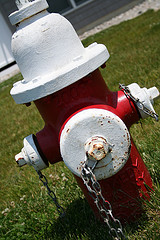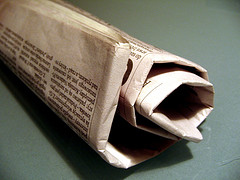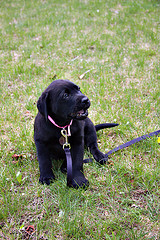Here at Crossbones Dog Academy, I work with a lot of dogs that are relieving themselves in the house. Housebreaking seems to be one of those things that either goes smoothly or is really troublesome. A lot of it depends on how your dog was raised, both before and after you acquired him.
Puppies raised on wire floor pens, such as dogs sold in pet stores, learn to relieve themselves where they sleep. This makes crate training and housebreaking difficult. Often new owners bring their puppy home and set them up in a playpen with newspaper or potty pads all over the floor. This encourages him to go anywhere he likes, whenever he pleases. These mistakes can create a habit of pottying in the house that can be tough to break.
Top Tips for Housebreaking
Here are some of my favorite tips for teaching dogs to go potty outdoors.
Pick up the food bowl. “Free-feeding” your dog – leaving the bowl full of food all the time – is a bad idea for a myriad of reasons. Switch to feeding your dog two or three times a day, at the same time every day. This is an easy way to regulate your dog’s “#2” schedule. Basically: scheduled input means scheduled output. Dogs typically relieve themselves shortly after eating a meal. If your dog is picking at his food dish whenever he pleases, you can’t take advantage of this function. Check out my post on free-feeding for tips on fixing this problem.
Clean up well. Even if it’s on a tile or linoleum floor, simply wiping up an accident with a paper towel isn’t going to cut it. A dogs’ sense of smell is approximately a thousand times better than ours, and they can still sniff out the spots where they have gone in the house unless you use a cleaner designed for dog waste. (We love Skout’s Honor products.) Dogs establish preferred “potty spots” quickly – don’t let your living room rug become one! Every dog owner should have an enzymatic cleaner on hand for accidents.
Get rid of the newspaper. This tip is a twofer. First, punishing a dog for an accident just teaches the dog to not potty in your presence. This means your dog may pee behind the sofa or under the bed, away from you. It also means they’ll be less likely to relieve themselves when you take them for a walk, because the last time they went potty in front of you, you scared them. (Punishing a dog for housebreaking accidents may also will make your dog hand-shy or fearful of you. Just don’t do it!)
If you are serious about teaching your dog to relieve himself outside, pick up any newspaper or “pee-pee pads” you have in the house. Your rule must be that pottying is only acceptable outdoors, it is never acceptable indoors. Putting down a substrate for your dog to go potty on in the house is terribly confusing to the dog. I often find that dogs trained to use newspaper or pads generalize this behavior to relieving themselves on bath mats, towels, door mats, throw rugs, and clothing on the floor.
(If you want to teach your dog to use one specific indoor dog potty area – not pee-pads – a trainer can help you come up with a plan to achieve this. I have even helped clients do this through phone consultations, so contact me if that’s something you’re interested in.)
Be ready to get outside. Set yourself up for housebreaking success by having your leash, clicker, treats, and slip-on shoes right next to the door, so that when it is time to get your dog outside, you are not wasting time looking for things. Why the clicker and treats? You can speed up the housebreaking process by clicking just as your dog finishes eliminating, then giving a treat.
Know when he goes. Dogs typically develop a schedule of relieving themselves. As an example, my adult dogs wake up and immediately go outside and pee. They eat breakfast, then go outside again and do both #1 and #2. They are crated or kenneled during the day while I am at work. When I arrive home in the mid-afternoon, they go out and pee. They eat dinner at the same time every evening, then immediately go outside and do #1 and #2. I take them out one more time before I go to bed and they will pee. It’s like clockwork.
Keep a record of when your dog gets a meal (or a really big treat), when he pees, and when he poops. Your record should distinguish between going outside or inside, so you can track your progress over time. Once you have kept records for a week or two, compare each day and see if you notice any patterns that you can take advantage of. You might notice that your dog is often having an accident at 7PM, so you start taking him outside at 6:30PM to prevent that.
Get professional help. If you are really struggling with teaching your dog to potty outdoors, or if your previously housetrained dog has suddenly begun eliminating in the house, contact your veterinarian. It could be a symptom of a larger problem. Teaching your dog to eliminate outdoors requires consistency, proper management, and a bit of patience! Once you have ruled out any health problems, get in touch with a positive reinforcement trainer who will help develop a plan if you still need help. Happy training!
Editor’s note: I originally published this post in 2017. I completely updated it in February 2024 as an effort to provide you, dear reader, with even more useful dog training information. Enjoy!



